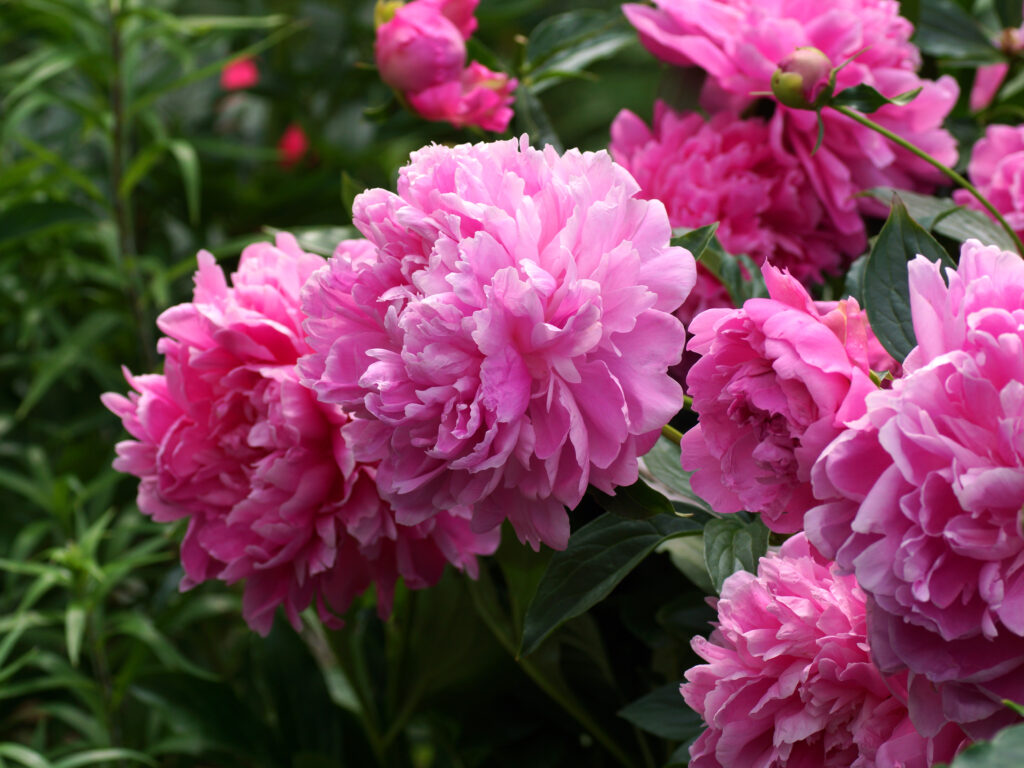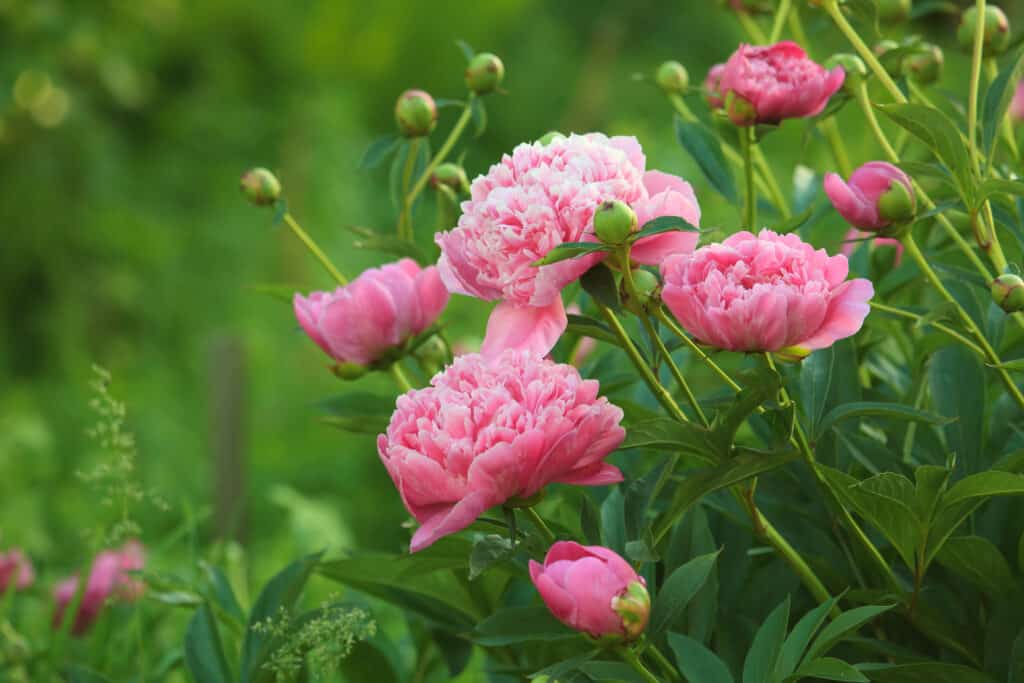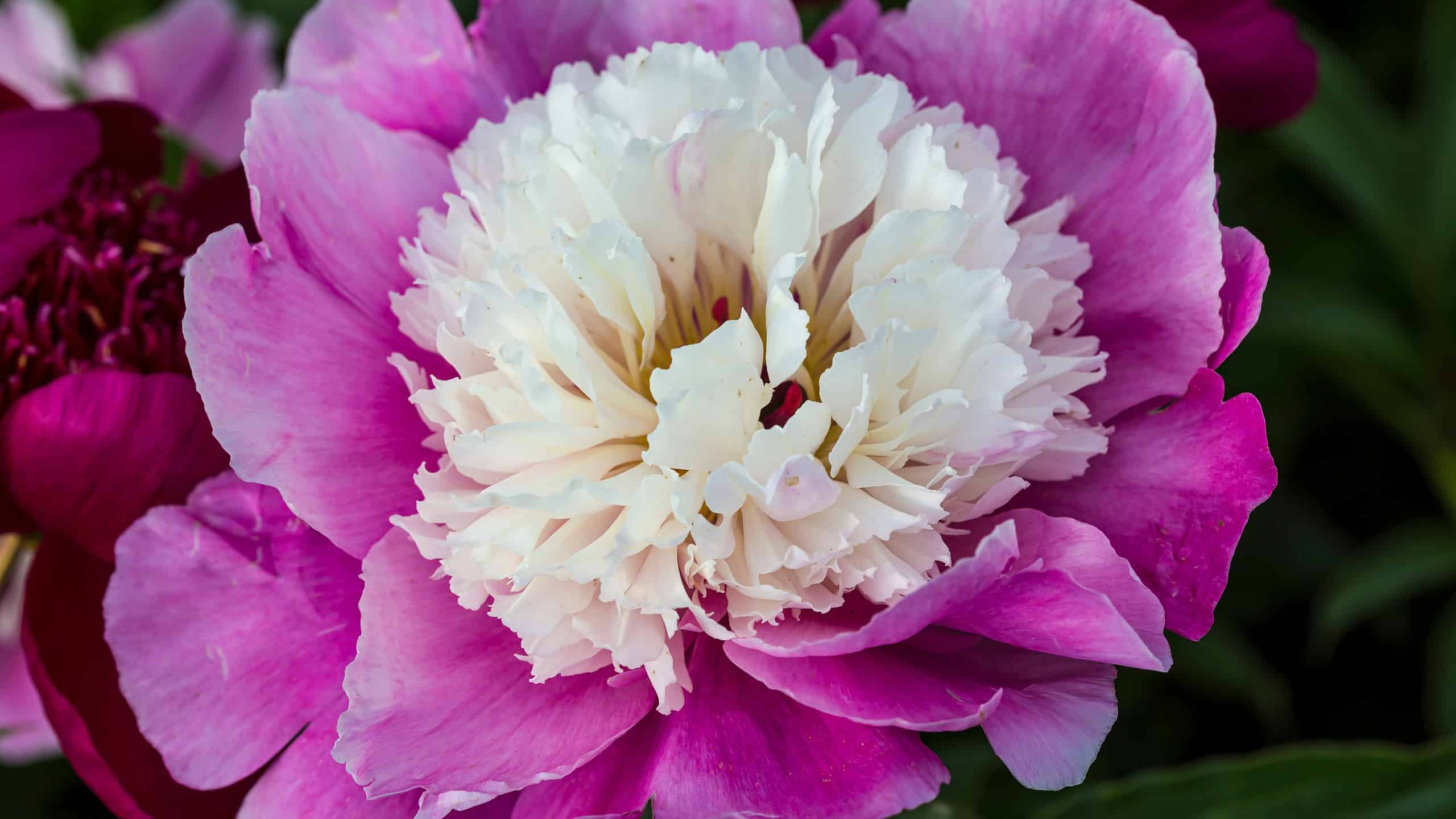The enduring popularity of peonies can be due to a number of things, including the particular place they have in the hearts of floral lovers everywhere. Their lavish blossoms, which come in a wide range of colors from delicate pastels to vivid colors, radiate elegance, splendor, and a hint of romance.
The appeal of peonies is further enhanced by their lovely fragrance, which fills the room with a lovely, alluring, and seductive aroma. From April to June, peonies are in full bloom in the autumn and at the beginning of summer.
The kind and variation chosen, the location, the timing of planting, care, and age will all affect when the plant blooms. Here is all the information you should have about when peonies are in season throughout the United States.
When Is Peony Season?

Peonies come in dozens of colors!
©Natali22206/Shutterstock.com
Peonies start blooming in the spring, like the majority of decorative flowering plants. They hold off on creating their magnificent blooms till the end of the season. Most northern hemisphere growers can anticipate the first bloom towards the end of April.
According to the type selected, the season will conclude around June, or about two months later, right when summer starts. While some types keep on blooming well into the next season, a lot of them finish flowering a bit earlier, in May.
Peonies are renowned for only flowering for a short period of time. Many of the these flowers only bloom a maximum of seven days, and if you’re lucky, up to ten days. If the correct circumstances are present, certain species will bloom for nearly two weeks.
These varieties require shaded locations, protection from the sweltering midday sun, and a small nitrogen boost through fertilization in order to keep their blooms. They will have a shorter season without this defense.
Because people adore these blossoms so much, horticulturists have bred peonies to create a species that blooms for a longer time. You can take pleasure in a full month’s worth of flowers because they can last for around a month.
Factors To Consider

Peonies are perennials!
©alex172/Shutterstock.com
There are several things to consider when or before planting peonies. Here are some things to keep in mind to ensure you get the most out of these stunning blooms.
Type of Peony
There are three primary types of peonies. Which one you choose has a major impact on how long these flowers take to bloom. Let’s take a look at the three main types.
Itoh
Toichi Itoh, a horticulturist from Tokyo, created the Itoh Peony in 1948. By combining the two varieties of peonies, a novel hybrid with herbaceous traits and leaves resembling those of trees was created.
Additionally, they generate up to 50 big flowers each season on a single plant. In addition to having the largest and most stunning blooms, these plants also flower for the longest time of all types of peonies.
Also known as Intersectional peonies, these flowers typically blossom in June and have an average three to four-week blooming duration. When the growing season is over, these plants will wither and turn into woody vegetation when winter arrives.
Herbaceous
The season for herbaceous peonies is the shortest, lasting about 10 days. Based on the variety, they often bloom in May or the first few weeks of June. They only grow in cooler climates and depend on cold spells to promote blooming.
Wintertime stem death is followed by springtime stem regrowth when the soil heats up.
Tree
Tree peonies have a season that lasts up to 14 days. They demand less cold than herbaceous varieties to develop flowers and are a little easier to cultivate. Additionally, the flowers are much bigger, and the greenery lasts all year long instead of withering away at the conclusion of the growing season.
They are among the first flowering species, starting to bloom in April and continuing through May.
Where You Live

Some varieties thrive in cooler temperatures while others require several hours of direct sunlight.
©larisa Stefanjuk/Shutterstock.com
Cold temperatures are necessary for Herbaceous Peonies to blossom. The other two varieties don’t need the outside temperature to plunge as low for their period of hibernation in the winter.
It’s crucial to plant the appropriate variety for your area. If placed incorrectly, a plant may blossom sparingly or, worse still, not at all. Cultivate herbaceous peonies if you live in an area with colder winters in USDA Zones two through eight.
Choose intersectional or tree peonies if you live within zones four through nine. Itoh peonies are a better choice for gardeners in the seven through nine zone area since they tolerate warm weather better.
In warmer climates, peonies will bloom earlier since the shift in the weather stimulates growth. Throughout extremely cold regions with springtime frosts, they will emerge later than normal.
In comparison to warmer areas, cooler, temperate zones typically see longer peony bloom times.
It’s important to pay attention to changes in your area as the seasons and temperature change. Growing your peonies early if spring arrives sooner will replicate the ideal circumstances and timing for optimum blooming.
Planting in Spring vs. Fall
The growing season is influenced by the time of year you plant. Peonies are frequently bought as bare-root plants, which means they are dormant when planted. The ideal time for planting is in the autumn, prior to the first frost.
According to your geographical position and region, this timing will vary, therefore before planting, verify your local meteorological information. By being planted in the fall, the plants have time to develop roots and adapt to the soil’s characteristics, which prepares them for the spring blooming season.

Peonies symbolize romance and prosperity.
©iStock.com/Birute
When all other conditions are held constant, this will increase the potential flowering season. You can also plant these beautiful flowers in the spring! It’s important to remember that after you plant them, they will prioritize developing roots over flowering during the spring.
If the plant blossoms at all, your initial flowering season is drastically cut short, and it may also have an effect on the flowering season next year. Starting in the fall is crucial if you want your plants to blossom for the longest amount of time possible right away.
How to Care For Peonies
Proper maintenance will help you reap what you can out of your blossoming season, just like with any flowering species. Peonies that are herbaceous and intersectional require at least five hours of direct sunlight each day in order to blossom.
The excessive sunlight and high temperatures, on the other hand, may strain the plant and shorten the duration that it can bloom, so tree varieties like shade in the afternoon. These plants don’t consume a lot of water, and in the warmer months, they may get by with just once-weekly watering.

Peonies are relatively low-maintenance flowers.
©iStock.com/
The right amount of moisture will affect the blooming time because water is crucial to photosynthesis, which provides the plant with the energy needed to make flowers. They require adequate drainage because they cannot tolerate wet soil, particularly throughout the winter when peonies are inactive.
To create the ideal circumstances, the soil ought to be loose and treated with organic matter prior to planting. Staking can help larger kinds grow better by supporting the load of the big buds.
To stop the stems from toppling over and breaking, gently tie them to a metal or wood stake. Every growing season, pruning, deadheading, and other maintenance tasks are needed for peonies.
How to Plant Peonies
Peonies should be placed between three and four feet apart in order for enough air to circulate. Threatening diseases that can hurt peonies can develop due to damp air or a lack of circulation.

Like tulips, peonies have to be planted straight-up.
©Mariia Boiko/Shutterstock.com
Choose an area that gets a lot of sunlight and make a large hole that is roughly two feet deep and two feet wide. Mixing in organic matter in the location for planting will improve the soil. You can use more compost to the ground if the soil happens to be too damp or dense.
Add approximately one cup of bonemeal to the ground. Place the roots in a position within the hole so that they’re just two inches beneath the soil’s surface, with the root’s eyes facing upward on top of a pile of soil.
Fill the hole back in and be aware of settling soil. Do this by gently tamping the ground without adding too much pressure. Don’t forget to water the area weekly to help your flowers bloom. There you have it! You’ve successfully planted peonies!
Thank you for reading! Have some feedback for us? Contact the AZ Animals editorial team.








